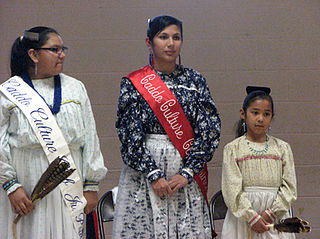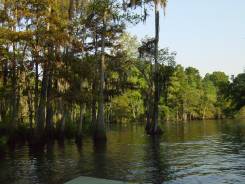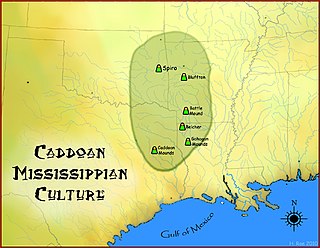
The Caddo people comprise the Caddo Nation of Oklahoma, a federally recognized tribe headquartered in Binger, Oklahoma. They speak the Caddo language.

The Adai were a Native American people of northwestern Louisiana and northeastern Texas. They were an Indigenous people of the Southeastern Woodlands and part of the Caddo Confederacy.

The Kichai tribe was a Native American Southern Plains tribe that lived in Texas, Louisiana, and Oklahoma. Their name for themselves was K'itaish.
The Hainai were a Native American tribe that lived in what is now east Texas.
The Nasoni are a Native American tribe from eastern Texas and southwestern Arkansas.
The Natchitoches are a Native American tribe from Louisiana and Texas. They organized themselves in one of the three Caddo-speaking confederacies along with the Hasinai, and Kadohadacho.
The Kadohadacho are a Native American tribe within the Caddo Confederacy. Today they are enrolled in the Caddo Nation of Oklahoma.
The Yatasi were Native American peoples from northwestern Louisiana that were part of the Natchitoches Confederacy of the Caddo Nation. Today they are enrolled in the Caddo Nation of Oklahoma.
The Nacono were a Native American tribe from eastern Texas. Today they are part of the Caddo Nation of Oklahoma, a federally recognized tribe in Oklahoma.
The Eyeish were a Native American tribe from present-day eastern Texas.
The Nadaco, also commonly known as the Anduico, are a Native American tribe from eastern Texas. Their name, Nadá-kuh, means "bumblebee place."
The Nabiti are a Native American tribe from eastern Texas. Their name means "Cedar Place" in the Caddo language.
The Nechaui were a Native American tribe from eastern Texas. Their name is thought to be derived from Nachawi, the Caddo language word for Osage orange.
The Ouachita are a Native American tribe who lived in northeastern Louisiana along the Ouachita River. Their name has also been pronounced as Washita by English speakers. The spelling "Ouachita" and pronunciation "Wah-sha-taw" came about as a result of French settlers and their influence. Many landscape features and places have been named for them since colonization of the region by Europeans and Americans.
The Nabedache were a Native American tribe from eastern Texas. Their name, Nabáydácu, means "blackberry place" in the Caddo language. An alternate theory says their original name was Wawadishe from the Caddo word, witish, meaning "salt."

The Nacogdoche are a Native American tribe from eastern Texas.
The Neche were a Native American tribe from eastern Texas.

The Caddoan Mississippian culture was a prehistoric Native American culture considered by archaeologists as a variant of the Mississippian culture. The Caddoan Mississippians covered a large territory, including what is now Eastern Oklahoma, Western Arkansas, Northeast Texas, Southwest Missouri and Northwest Louisiana of the United States.

Caddo Mounds State Historic Site (41CE19) is an archaeological site in Weeping Mary, Texas. This Caddoan Mississippian culture site is composed of a village and ceremonial center that features two earthwork platform mounds and one burial mound. Located on a precontact Native American trail later named by the Spanish as El Camino Real de los Tejas, the settlement developed hundreds of years before the arrival of Europeans to the region. Archaeologists believe the site was created in approximately 800 CE, with most major construction taking place between 1100 and 1300 CE.








